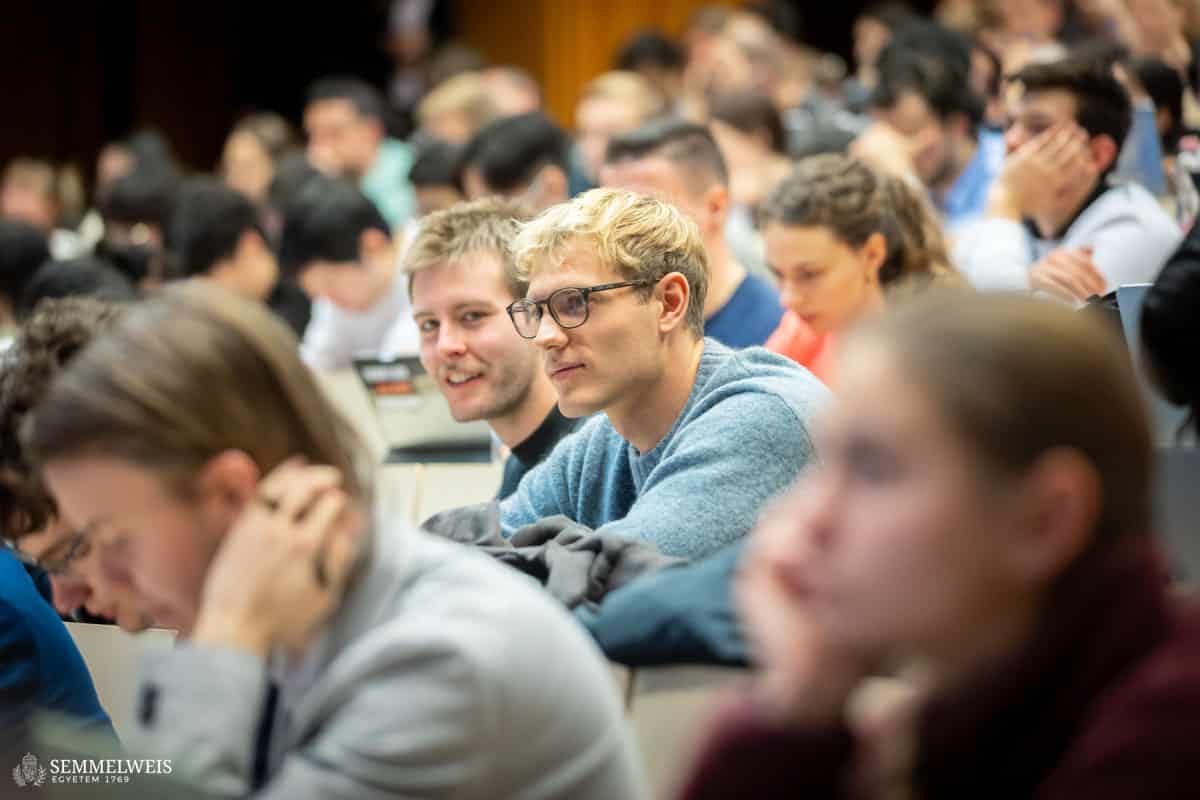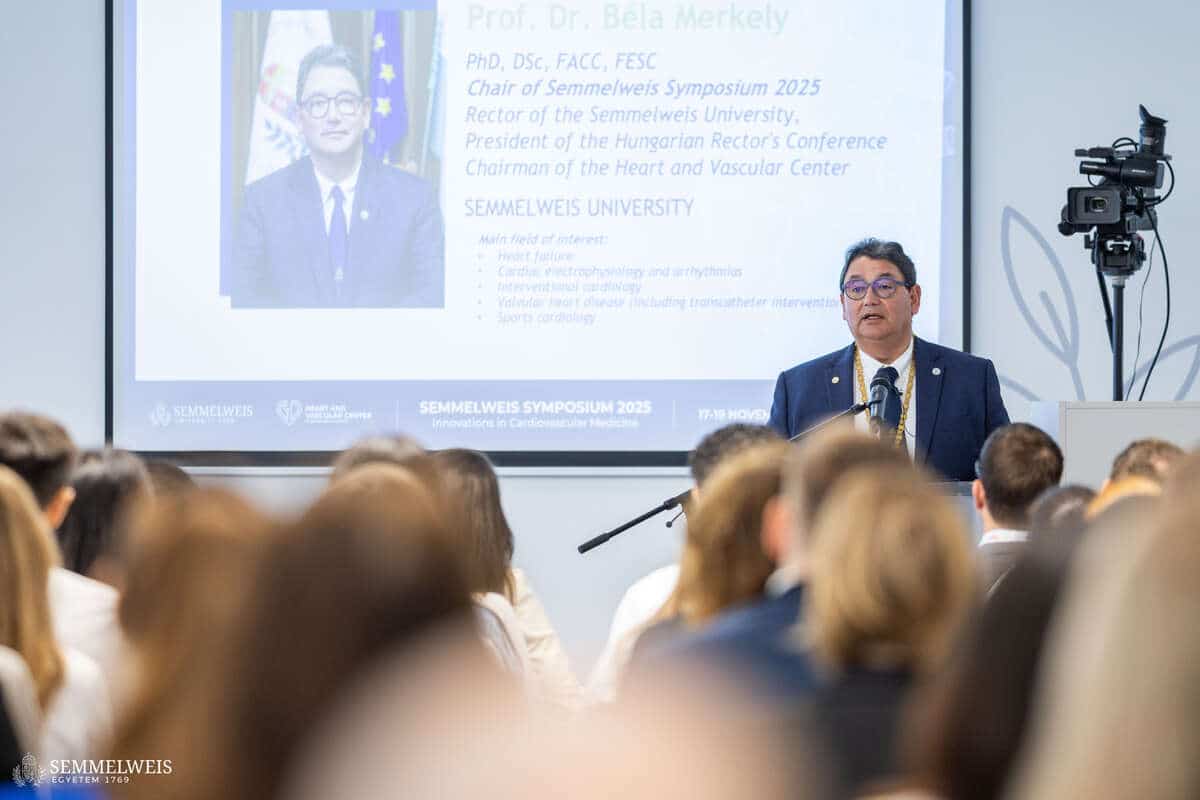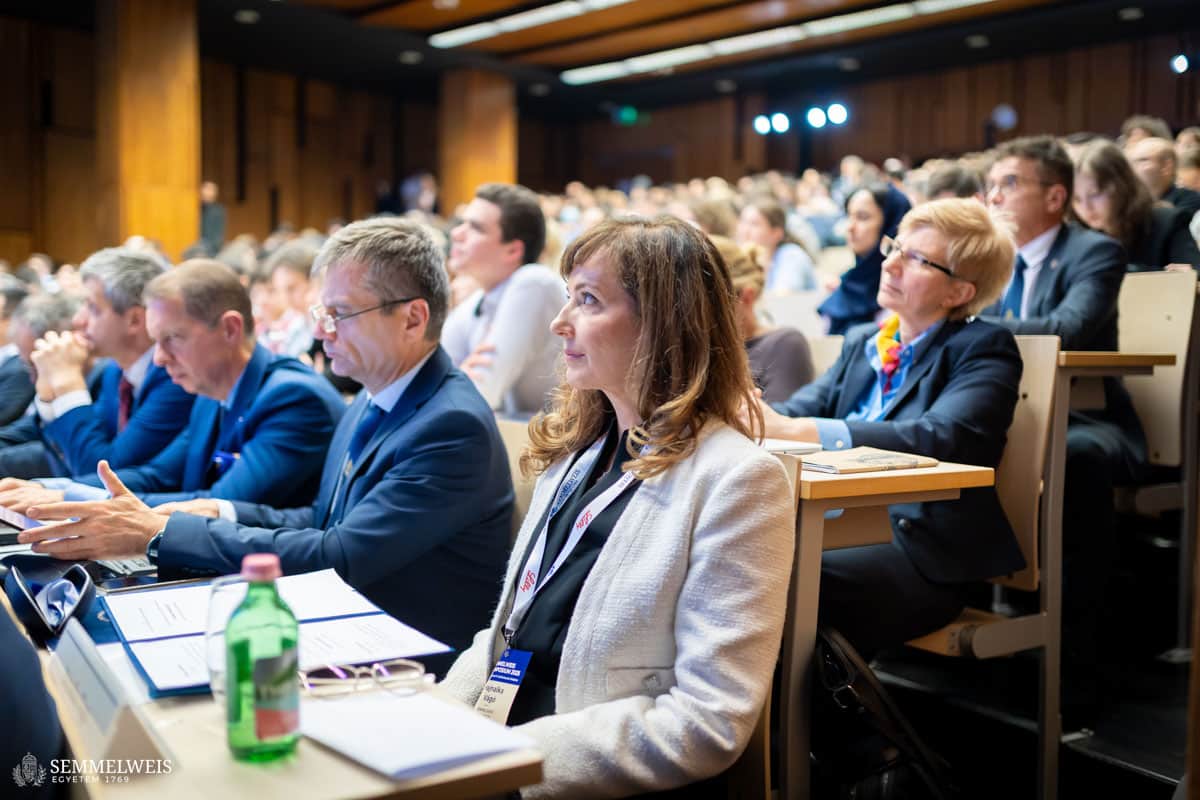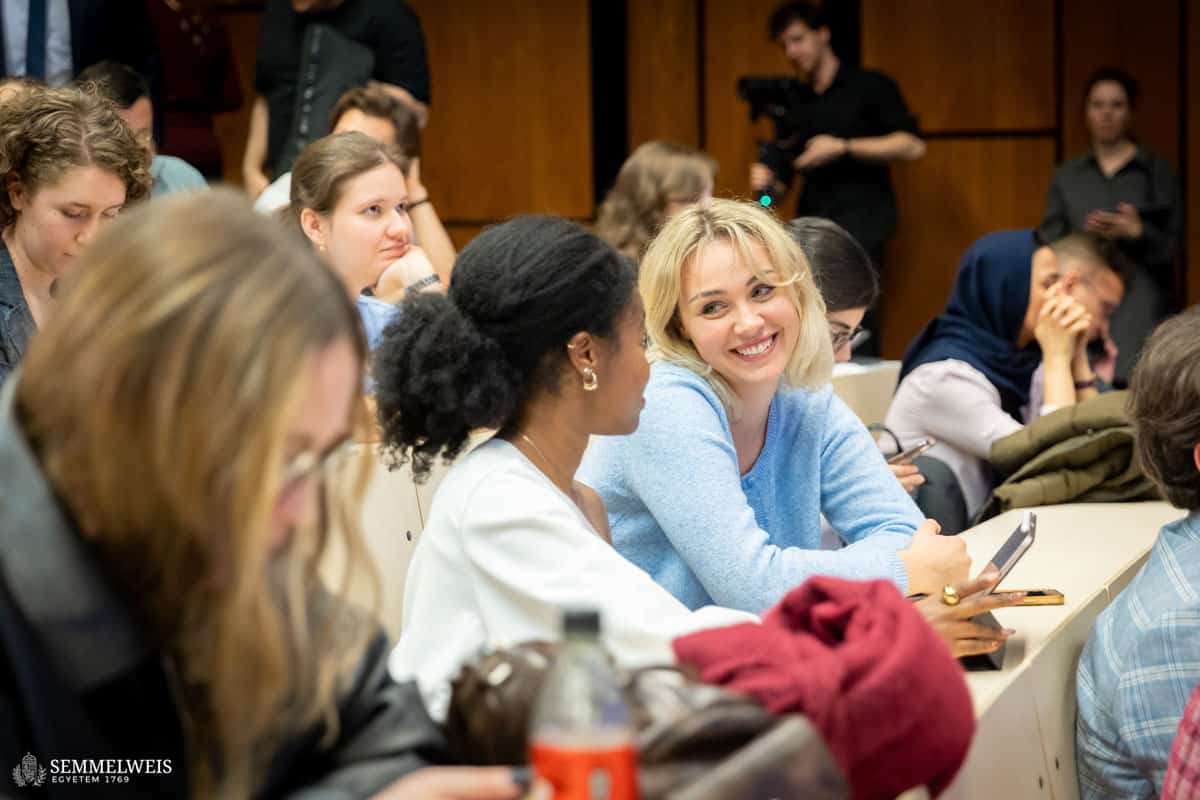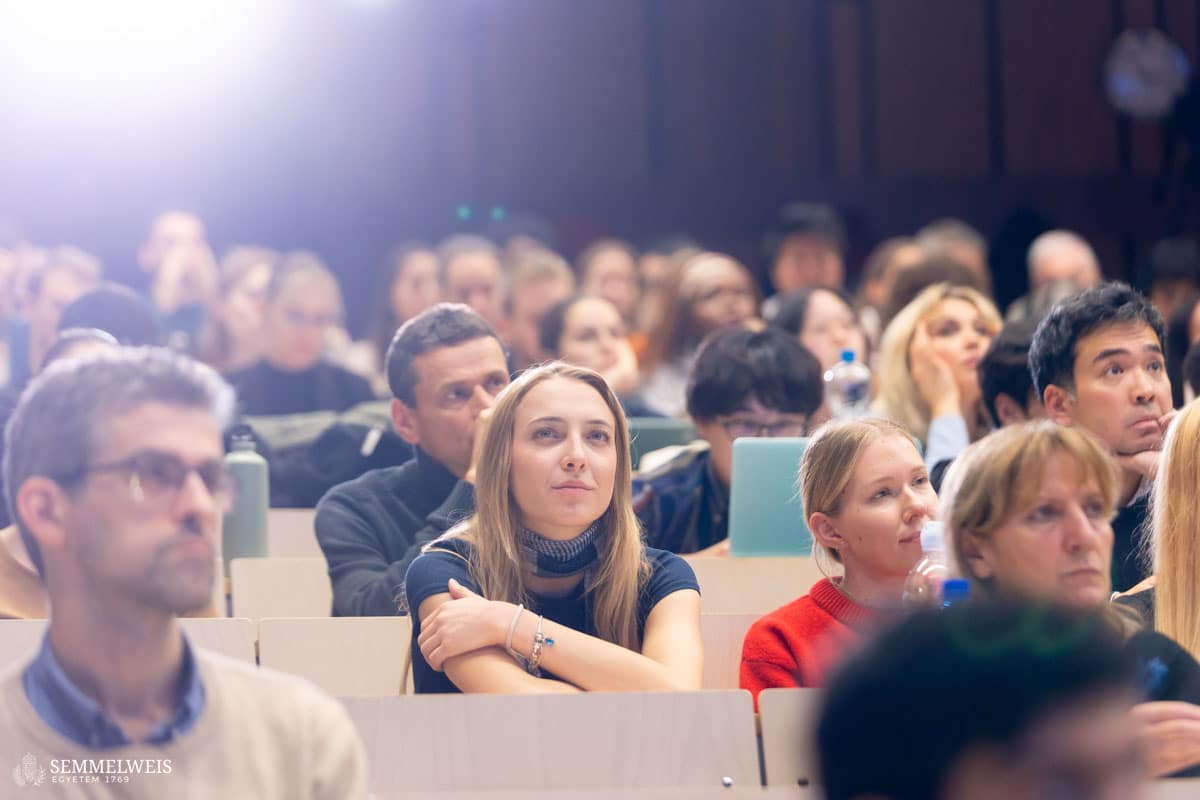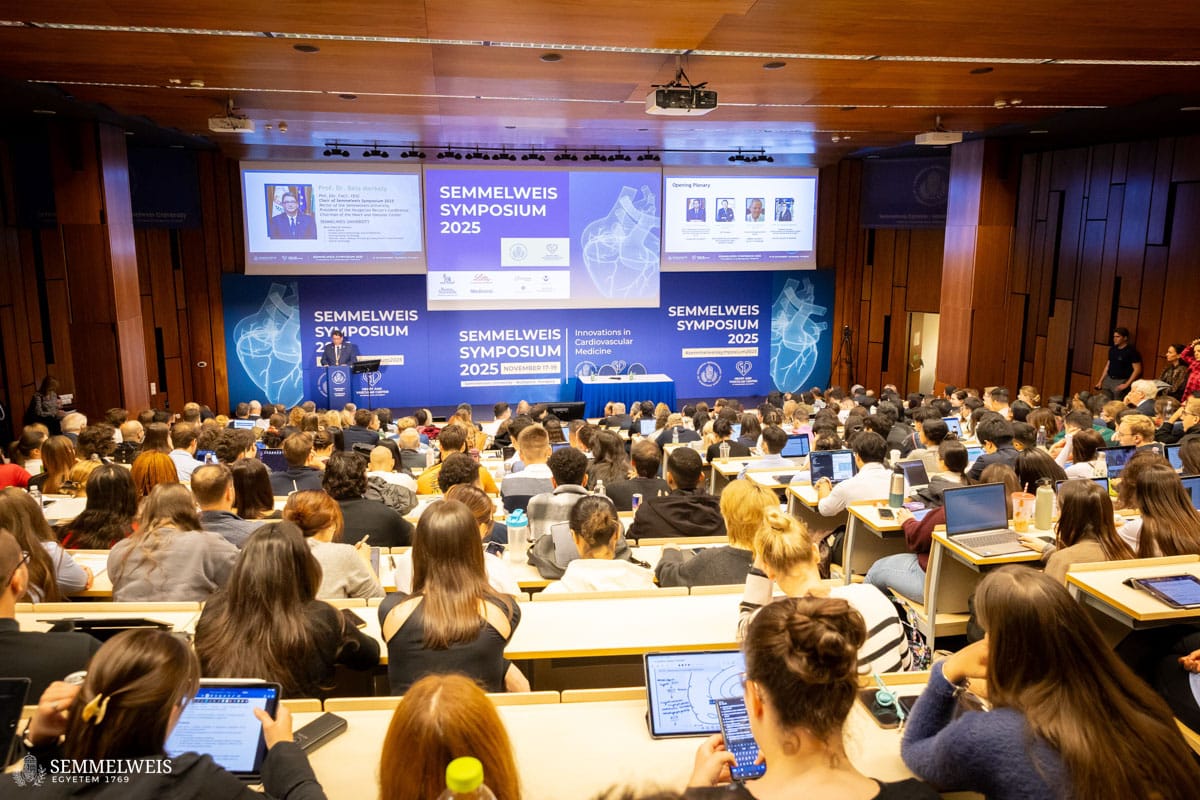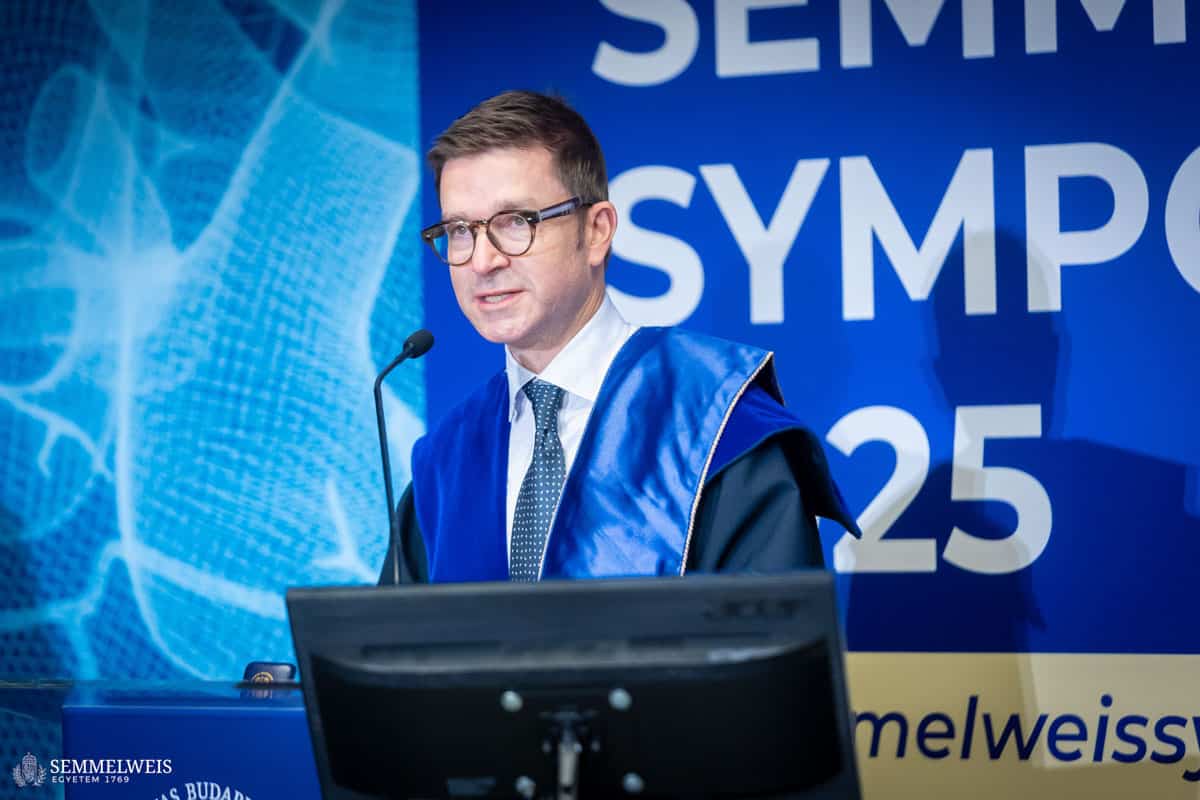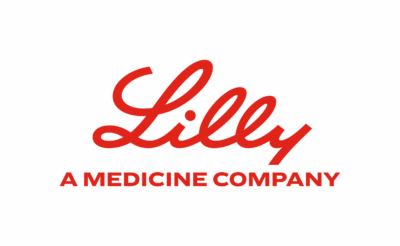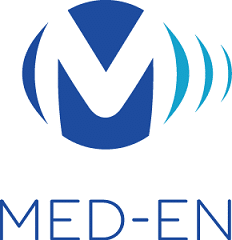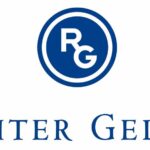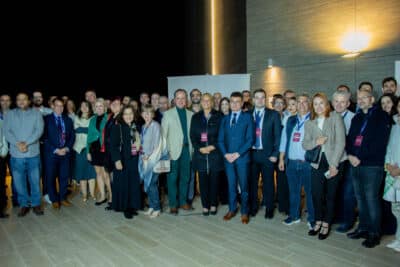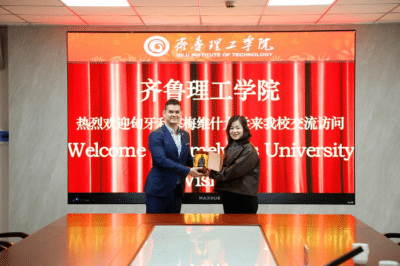The university’s most prestigious scientific event, the 33rd Semmelweis Symposium, took place at two locations with a more complex program than ever before, with more than 1,200 participants registered this year. The 59 international speakers at the three-day program came from 26 countries around the world, from the United States and Central and Eastern Europe to Singapore, representing the entire spectrum of the discipline.
Over three days, participants reviewed the latest developments in cardiovascular medicine in 52 presentations and panel discussions in 12 sessions at the Basic Medical Science Center, led by international experts such as Dr. Cecilia Linde, Dr. Domenico Corrado, Dr. Michael Glikson, Dr. Martin Czerny, Dr. Gustavo Oderich, Dr. Jeanette Schulcz-Menger, Dr. Julie de Backer, Dr. Neil Basu, Dr. Stefan D. Anker, Dr. Gerhardt Hindricks, Dr. Scott Solomon, and Dr. Robert Hatala.
In parallel with the professional program at EOK, 35 presentations and panel discussions took place in 8 sessions at the Városmajor Heart and Vascular Center, focusing mainly on the latest developments and scientific findings in vascular surgery, electrophysiology, and imaging technologies used in vascular surgery and cardiology. The clinical program included five workshops and a professional roundtable discussion with the participation of experts from the Central European region.
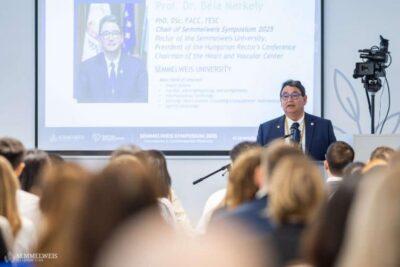 The three-day series of events began at the Városmajor Heart and Vascular Center and then at the Basic Medical Science Center with a welcome address by Dr. Béla Merkely, Director of the Városmajor Heart and Vascular Center and Rector of Semmelweis University. In his opening speech, he recalled that the university had been organizing the Semmelweis Symposium with international participation since 1992. He said that, in addition to stimulating academic life at the university, the primary goal of the event was to build cross-border relationships and promote international knowledge transfer, as this was the only way to achieve progress and success today. Regarding cardiovascular medicine, which is the focus of the current symposium, he said that Semmelweis had been ranked among the world’s top 50 institutions for years in this field and was currently listed as 35th in the latest US News rankings. The results achieved are attributable not only to the increasing excellence of scientific work, but also to the international character of the university, as reflected in the high proportion of international students and extensive professional partnerships. “However, all this comes with not only opportunities but also responsibilities: We work for our patients, educate future healers, and promote scientific research in a way befitting our role as standard-bearers – and our current event fits in perfectly with these aspirations,” he emphasized.
The three-day series of events began at the Városmajor Heart and Vascular Center and then at the Basic Medical Science Center with a welcome address by Dr. Béla Merkely, Director of the Városmajor Heart and Vascular Center and Rector of Semmelweis University. In his opening speech, he recalled that the university had been organizing the Semmelweis Symposium with international participation since 1992. He said that, in addition to stimulating academic life at the university, the primary goal of the event was to build cross-border relationships and promote international knowledge transfer, as this was the only way to achieve progress and success today. Regarding cardiovascular medicine, which is the focus of the current symposium, he said that Semmelweis had been ranked among the world’s top 50 institutions for years in this field and was currently listed as 35th in the latest US News rankings. The results achieved are attributable not only to the increasing excellence of scientific work, but also to the international character of the university, as reflected in the high proportion of international students and extensive professional partnerships. “However, all this comes with not only opportunities but also responsibilities: We work for our patients, educate future healers, and promote scientific research in a way befitting our role as standard-bearers – and our current event fits in perfectly with these aspirations,” he emphasized.
Our goal is to ensure that the latest scientific advances in diagnostics, imaging technology, drug, interventional, and surgical therapies reach as many specialists and future physicians as possible and are applied at the bedside as soon as possible. – Dr. Béla Merkely
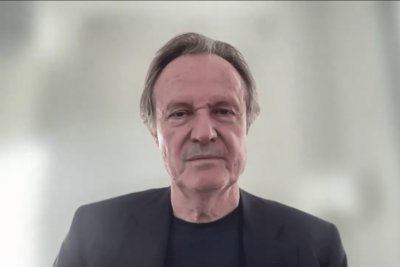 Dr. Thomas F. Lüscher, President of the European Society of Cardiology (ESC), welcomed the audience in a video message. As he explained, since the discovery of the stethoscope and the introduction of Ignác Semmelweis’s disinfection protocol, cardiology – and medicine at large – has achieved major progress, with the introduction of fantastic imaging techniques, medications, and devices that have made it possible to treat all kinds of conditions. He emphasized that European cardiology has been at the forefront of introducing new procedures such as percutaneous transluminal coronary angioplasty (PTCA) and minimally invasive Left Atrial Appendage Occlusion (LAAO) procedures. Medications have also undergone revolutionary changes with the advent of aspirin, p2y12 inhibitors, heart failure drugs, and anticoagulants, and more recently through research into the interference between nucleic acids and proteins. “We are in a fantastic position, but we still have to work further, as cardiovascular disorders remain the leading cause of mortality across Europe,” he emphasized. In line with this, the European Society of Cardiology held consultations with the European Union’s organs regarding the development of the European Cardiovascular Health Plan, in which Dr. Béla Merkely and Hungary’s rotating presidency also played a leading role. Thomas F. Lüscher expressed his hope that this action plan would result in even more funding being made available for cardiovascular research from 2026 onwards.
Dr. Thomas F. Lüscher, President of the European Society of Cardiology (ESC), welcomed the audience in a video message. As he explained, since the discovery of the stethoscope and the introduction of Ignác Semmelweis’s disinfection protocol, cardiology – and medicine at large – has achieved major progress, with the introduction of fantastic imaging techniques, medications, and devices that have made it possible to treat all kinds of conditions. He emphasized that European cardiology has been at the forefront of introducing new procedures such as percutaneous transluminal coronary angioplasty (PTCA) and minimally invasive Left Atrial Appendage Occlusion (LAAO) procedures. Medications have also undergone revolutionary changes with the advent of aspirin, p2y12 inhibitors, heart failure drugs, and anticoagulants, and more recently through research into the interference between nucleic acids and proteins. “We are in a fantastic position, but we still have to work further, as cardiovascular disorders remain the leading cause of mortality across Europe,” he emphasized. In line with this, the European Society of Cardiology held consultations with the European Union’s organs regarding the development of the European Cardiovascular Health Plan, in which Dr. Béla Merkely and Hungary’s rotating presidency also played a leading role. Thomas F. Lüscher expressed his hope that this action plan would result in even more funding being made available for cardiovascular research from 2026 onwards.
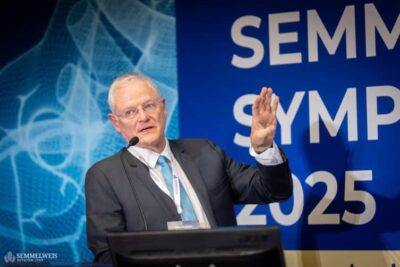 Dr. Michael Glikson, Director of the Jesselson Integrated Heart Center, Past President of the Israel Heart Society, and Professor at the Hebrew University of Jerusalem, gave a keynote lecture on the latest trends in the LAAO procedure. In his presentation, he examined how LAAO can help prevent embolism in patients with atrial fibrillation. In these patients, blood clots usually form in the left atrial appendage, increasing the risk of stroke. As he pointed out, oral anticoagulants reduce the risk of stroke but increase the risk of bleeding. However, with LAAO devices such as Amulet and Watchman, the appendage can be closed, thereby reducing the risk of blood clots. Clinical trials have shown that the LAAO procedure is no less effective than anticoagulants in preventing stroke, making it particularly suitable for those who cannot take anticoagulant medications. It is the role of ongoing studies to investigate the use of LAAO in lower-risk patients. Among future trends, he mentioned new devices, improved imaging techniques, and possible ways to optimize post-procedural therapy.
Dr. Michael Glikson, Director of the Jesselson Integrated Heart Center, Past President of the Israel Heart Society, and Professor at the Hebrew University of Jerusalem, gave a keynote lecture on the latest trends in the LAAO procedure. In his presentation, he examined how LAAO can help prevent embolism in patients with atrial fibrillation. In these patients, blood clots usually form in the left atrial appendage, increasing the risk of stroke. As he pointed out, oral anticoagulants reduce the risk of stroke but increase the risk of bleeding. However, with LAAO devices such as Amulet and Watchman, the appendage can be closed, thereby reducing the risk of blood clots. Clinical trials have shown that the LAAO procedure is no less effective than anticoagulants in preventing stroke, making it particularly suitable for those who cannot take anticoagulant medications. It is the role of ongoing studies to investigate the use of LAAO in lower-risk patients. Among future trends, he mentioned new devices, improved imaging techniques, and possible ways to optimize post-procedural therapy.
 The second keynote presentation was given by Gustavo S. Oderich, Professor of Surgery at Baylor College of Medicine. In his presentation, he outlined the development of endovascular aortic reconstruction (EVAR) from its beginnings in the 1980s to the current treatment of complex aortic diseases. He emphasized that, based on a review of 900 cases, this technology shows increasing effectiveness and decreasing mortality rates. EVAR is now widely used for degenerative, dissecting, and hereditary aortic diseases, although open surgery remains essential for certain patients. According to the American ART registry, short-term mortality is lower with EVAR than with open surgery, but secondary interventions are still often necessary. The field is constantly evolving through centralization and AI-driven care, Gustavo S. Oderich pointed out in his presentation.
The second keynote presentation was given by Gustavo S. Oderich, Professor of Surgery at Baylor College of Medicine. In his presentation, he outlined the development of endovascular aortic reconstruction (EVAR) from its beginnings in the 1980s to the current treatment of complex aortic diseases. He emphasized that, based on a review of 900 cases, this technology shows increasing effectiveness and decreasing mortality rates. EVAR is now widely used for degenerative, dissecting, and hereditary aortic diseases, although open surgery remains essential for certain patients. According to the American ART registry, short-term mortality is lower with EVAR than with open surgery, but secondary interventions are still often necessary. The field is constantly evolving through centralization and AI-driven care, Gustavo S. Oderich pointed out in his presentation.
At the close of the opening ceremony of the 2025 symposium, Professor Gustavo S. Oderich was awarded an honorary doctorate from Semmelweis University on the recommendation of the Faculty of Medicine (ÁOK). In his opening remarks at the Doctor Honoris Causa ceremony, Rector Dr. Béla Merkely recalled that the university awards honorary doctorates to internationally recognized professors who have close ties to the institution and to whom Semmelweis University owes the most. The scientific relationships that the university reinforces with this award are key to Semmelweis developing into the institution as we know it today: a world-class university. “I am confident that your relationship with Semmelweis University will continue to be productive and fruitful! I am delighted that we are strengthening our collegial relationships even further by complementing them with a sense of kinship. In addition to our gratitude, this award symbolizes that you are now a member of the great Semmelweis Family,” said the rector to the award winner. In his laudatory speech, Dean Dr. Péter Nyirády emphasized that Professor Oderich is a leading figure in the modern era of minimally invasive aortic surgery. At the forefront of the endovascular revolution, his characteristic field of expertise – fenestrated and bifurcated endovascular aortic reconstruction (FB-EVAR) – has expanded the treatment options for patients with complex thoracoabdominal and arch aneurysms, which previously could only be treated with open surgery. Through innovation, rigorous clinical science, and precise technique, he has contributed to expanding indications, improving patient safety, and promoting international dissemination of best practices. Semmelweis University has benefited directly from his talks and teaching at the Városmajor Heart and Vascular Center and the Semmelweis International Vascular Symposium (SIVS), and his influence can be seen in the university’s internship training, research, and international partnerships.
Following the laudation, Rector Dr. Béla Merkely and Dean Dr. Péter Nyirády presented Professor Gustavo S. Oderich with his honorary doctorate certificate and stole. In his personal acceptance speech, the honoree emphasized that every new step in medicine is only possible with the support of mentors, colleagues, and family members, and he expressed his special gratitude to his wife and to Dr. Péter Gloviczki, an alumnus of the university. “With the advancement of technology, we must not forget that progress in medicine stems not only from innovation, but also from empathy, integrity, and the courage to question dogma, as Semmelweis did in his day,” said Dr. Gustavo S. Oderich, sharing his credo.
You can read about the detailed professional program of the symposium in the next part of our report.
Judit Szabados-Dőtsch
Translation: Dr. Balázs Csizmadia, Judit Szabados-Dőtsch
Photos by Bálint Barta, Boglárka Zellei – Semmelweis University


